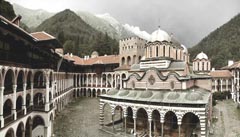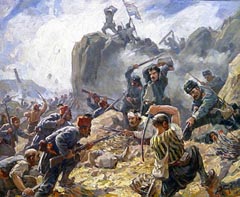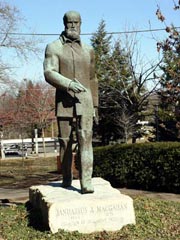Bulgaria Under Turkish Rule (1393-1878)
The Ottoman Turks first came to Europe in 1345, and made their first settlement in Europe on Gallipoli in 1354. Having overrun Thrace in 1361, they took Adrianople four years later and made it their first real capital in Europe. By July 17th, 1393, they conquered Turnovo, the capital of the Second Bulgarian Empire, and in 1396 they reached Vidin, the last Bulgarian stronghold. Thus, the Turks conquered the Second Bulgarian Kingdom and ruled over the Bulgarian land for nearly five hundred years.
The Turkish invasion in Europe during the fourteenth century brought great revolts among the Balkan states and eventually changed the map of the Balkan Peninsula. The Turks conquered in succession the Bulgarians, the Serbians, the Greeks, the Romanians, and the Albanians. Their countries vanished, and in their place arose a powerful Ottoman Empire, which was involved in the political affairs in Europe from 1353 until its expulsion from Europe in 1912.
The Bulgarian church, school, social institutions, culture, literature, and even the language were passing the darkest period in the history of the Bulgarian people. The latter were now not only under the political domination of the Sultan of Turkey, but also under the spiritual oppression of the Greek Patriarchate of Constantinople.
The Bulgarian leaders became convinced that no better opportunity to strike for freedom would ever arise and they vigorously began preparations for a general insurrection in Bulgaria. On April 19th, 1876 the citizens of the town of Koprivshtitsa declared a state of insurrection. The population of the mountain towns and villages, such as Panagurishte, Klisoura, and Batack, well known for their alertness and love for freedom, hastened into the mountains, where they were barely able to hold their own against the Turkish forces. The fury of the Turks knew no bounds; they resolved wholly to exterminate the disloyal giaours. The vengeance of the Turks was carried to such atrocious proportions that there is hardly a parallel in all the European history.
The London Times correspondent, A. Gallanga, quoted only one letter, which appeared in the Times on July 8th, 1876. Its brief content showed the character of the Turkish action. Among the many things it stated were:
1) More than 100 Bulgarian towns have been utterly destroyed.
2) At least 25,000 unarmed and inoffensive people have been massacred in cold blood.
3) More than 1,000 Bulgarian children have been taken and sold as slaves.
4) Horrible tortures of every description have been inflicted on thousands of those not murdered.
The Liberation of Bulgaria
The European powerful countries wanted to maintain peace in Europe, and they definitely recognized that this was impossible unless Turkey adopted a program of reforms embracing the volatile region of Bulgaria and Bosnia-Herzegovina. In a supreme effort to prevent further violence, the great powers – England, Russia, Germany, Austria-Hungary, and Italy – along with Turkey - announced an International Ambassadorial Conference to be held in Constantinople in order to consider the problem of the Bulgarian April insurrection and thereby resolve the Bulgarian problem.
An armed conflict was not inevitable for Russia was now at the end of her patience. Of all European states, Russia alone was the first to claim the right to protect the Christians living within the Ottoman Empire. On April 24th, 1877, Russia declared war on Turkey and by June 27th the Russian army crossed the Danube River and moved to the Balkans. In the early part of 1878, the Turkish army was devastatingly defeated. The road to Constantinople was clear. The victorious Russian army, assisted by thousands of Bulgarian volunteers, advanced almost within sight of the minarets of Constantinople.
A peace treaty was then signed in the town of San Stefano on March 3rd, 1878 – hence the name San Stefano Treaty - and Bulgaria gained her independence.
Now March 3rd is celebrated as Bulgarian Independence Day.
Americans in Bulgaria’s history
Had it not been for the Americans of Robert College, especially Dr. Washburn, Dr. Long and others who had urged the Americans minister in Constantinople Horace Maynard, to send a special offer to the suffering areas affected by the Turkish atrocities and thereby ascertain whether or not the published newspaper stories were correct, the world would have soon forgotten about the cruel suppression of the Bulgarian April insurrection. It would have merely been considered another Balkan event. Credit is really due, however, to two courageous Americans who had arrived at the devastated spot to observe and graphically describe the actual occurrences. These two men were the diplomat Eugene Schuyler and the Irish-American journalist Januaries A. MacGahn.
In 1867, Eugene Schuyler was appointed American consul-general in Moscow and, in 1869, Secretary of the American Legation in Petrograd. In the summer of 1876, Schulyer had been transferred to the American Legation in Constantinople. At the time, the April insurrection had already been suppressed. But when Schuyler took his post as consul-general, the topic of conversation in the diplomatic offices and the press was the “Eastern Question”- a synonym for the Bulgarian Question. At the same time, however, Dr. Washburn and Dr. Long had urged the American minister in Constantinople, Horace Maynard, send a special offer to the suffering areas affected by the Turkish atrocities and thereby confirm whether or not the published stories were correct. Maynard had decided to send the newly arrived Eugene Schuyler. The latter was ordered to go to Adrianople and from there to Plovdiv and the Tater-Pazardijk regions.
Meanwhile, the London Daily News sent a special correspondent to investigate the reported massacres on the spot. This man was very eminent journalist J. A. MacGahn who, as military correspondent for the New York World, had covered the Franco-Prussian War of 1871. Eugene Schuyler accompanied by Peter Dimitroff, a graduate from Robert College as an interpreter, along with MacGahn, who acted as Schuyler’s secretary, arrived at the designated regions in Bulgaria. They set out from Constantinople in July 23, 1876. Letters and telegrams had been sent out to the Daily News confirming the stories about the atrocities. Visiting the town of Batak, MacGahn and Schuyler were shocked at the sight of the devastated town.
MacGahn’s letter of August 2, 1876, sent from Tatar-Pazardjik and published in the Daily News, provoked the inevitable Russo-Turkish War. The letter not only reflected the shock of what MacGahn saw but also expressed sympathy for the people who struggled to realize the same ideals for which the American people who fought only a century before. MacGahn never saw the creation of a free Bulgarian state, for which he shook the consequence of Europe On June 9, 1878. On the eve of the International Congress of Berlin, he was stricken with a malignant fever, died in Constantinople, and was buried in Pera, with the distinguished Russian General Mihail D. Skobeleff attending his funeral.
The American people paid tribute to the memory of this freedom-loving man in an unusual way. In 1884 his remains were disinterred at Constantinople and brought to America on the U.S. steamer lay in state for a day, as well as at the funeral in New Lexington, Ohio thousands of Americans paid tribute to the memory of MacGahn. Seventeen years later, on the Fourth of July-American Independence Day - the monument of Januarious Aloysius MacGahn was unveiled, with the epitaph “MacGahn, Liberator of Bulgaria.”
The articles are presented by Iskra Balchev

The Bulgarian literature, religion and culture were saved in the Bulgarian monasteries.

The most decisive battle of Shipka during the Russian-Turkish war of Liberation.

The monument of Januarious Aloysius MacGahn, with the epitaph
“MacGahn, Liberator of Bulgaria”
